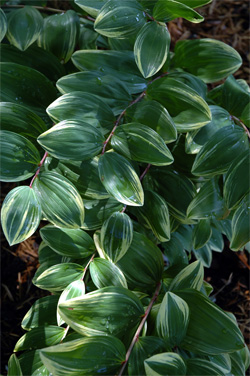Plant of the Month – November, 2007

At a glance
Latin Name: Polygonatum odoratum variegatum
Common Name: Variegated Solomon’s Seal
Plant type: perennial
Flowers: tiny cream-colored bells
Foliage: variegated, coarse
Mature height: 2 feet
Hardiness: winter hardy to Zone 4
Soil: well-drained with organic
amendment
Exposure: shade
Water usage: medium
Sources: local nurseries or mail order
Shade in Texas — the Texas gardener’s lament! All those great shade plants listed in those hundreds of mail order catalogs we get are sure to languish and die in our heat. I’ve dreamed of giant hosta and all of those other great plants we can’t grow.
Then I found variegated Solomon’s seal. I would never have guessed this plant would live here. Thanks to a gardening friend, I was proven wrong. The
friend showed me a small branch of this plant and asked if I thought it would live here. I said absolutely not, and then was ushered to a whole bed filled with it on the side of their house.
I love this plant in shade! Arching branches of foliage hold large leaves bordered with wide, creamy white edges. The spreading rhizomes will form large colonies eventually; I’ve had plants spread to 3 – 4 ft. across. Don’t try to use it as a groundcover, though. It can take a while before it starts to spread. In late spring the arching branches produce delicate little one-inch bells of flowers under the leaves. If you aren’t looking for them, you’ll miss them.
I’ve seen this plant sold in local nurseries in quart and one-gallon containers. It is also readily available from mail order companies. Plant it in shade under deciduous trees or on the north side of the house. I have noticed that this plant does not like any direct sunlight during the day. Amend the soil with organic matter and water regularly during dry spells. Once plants are established, they are quite drought tolerant. I use it as a companion plant with wood fern (Thelypteris kunthii). The variegated foliage complements the lacy, soft-textured foliage of the fern.
In case you are curious, the name "Solomon’s Seal" is taken from the shape of the scar on the rhizome where the stem attaches. In some species this scar takes the form of two overlapped triangles, the ancient symbol of King Solomon.
About the author: Jimmy Turner is the Director of Horticulture Research at the Dallas Arboretum. Visit www.dallasplanttrials.org for information on his trials. For more plant profiles by Jimmy, subscribe to Neil Sperry’s GARDENS Magazine.
